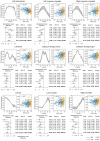Reproducible Abnormalities and Diagnostic Generalizability of White Matter in Alzheimer's Disease
- PMID: 37014553
- PMCID: PMC10533766
- DOI: 10.1007/s12264-023-01041-w
Reproducible Abnormalities and Diagnostic Generalizability of White Matter in Alzheimer's Disease
Abstract
Alzheimer's disease (AD) is associated with the impairment of white matter (WM) tracts. The current study aimed to verify the utility of WM as the neuroimaging marker of AD with multisite diffusion tensor imaging datasets [321 patients with AD, 265 patients with mild cognitive impairment (MCI), 279 normal controls (NC)], a unified pipeline, and independent site cross-validation. Automated fiber quantification was used to extract diffusion profiles along tracts. Random-effects meta-analyses showed a reproducible degeneration pattern in which fractional anisotropy significantly decreased in the AD and MCI groups compared with NC. Machine learning models using tract-based features showed good generalizability among independent site cross-validation. The diffusion metrics of the altered regions and the AD probability predicted by the models were highly correlated with cognitive ability in the AD and MCI groups. We highlighted the reproducibility and generalizability of the degeneration pattern of WM tracts in AD.
Keywords: Alzheimer’s disease; Cross-validation; Diffusion tensor imaging; White matter tracts.
© 2023. Center for Excellence in Brain Science and Intelligence Technology, Chinese Academy of Sciences.
Conflict of interest statement
The authors declare that there are no conflicts of interest.
Figures





References
MeSH terms
LinkOut - more resources
Full Text Sources
Medical

